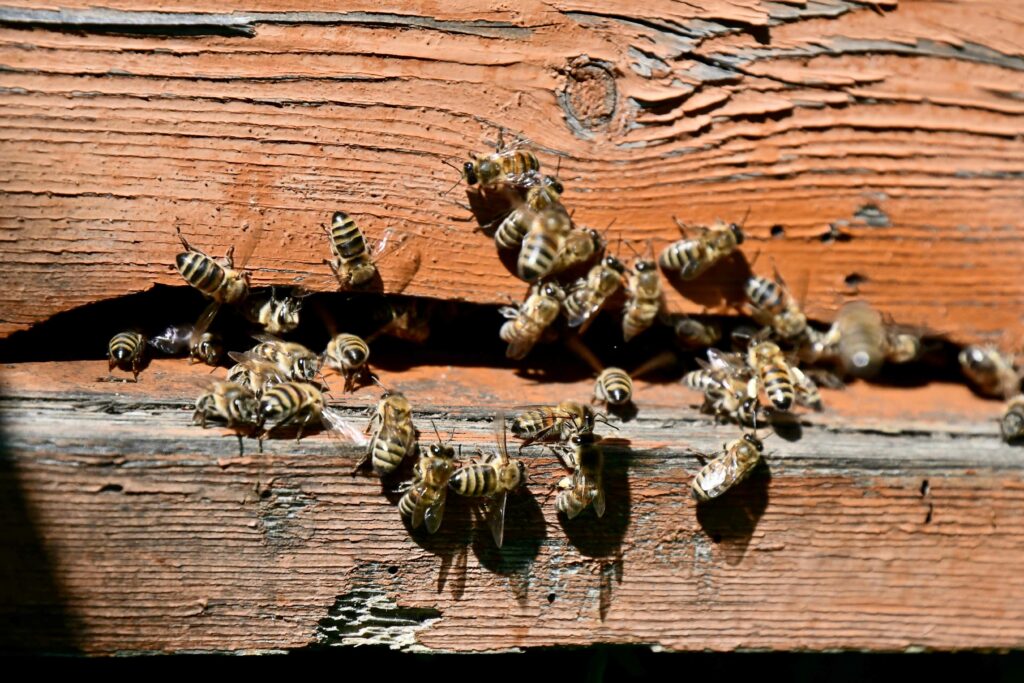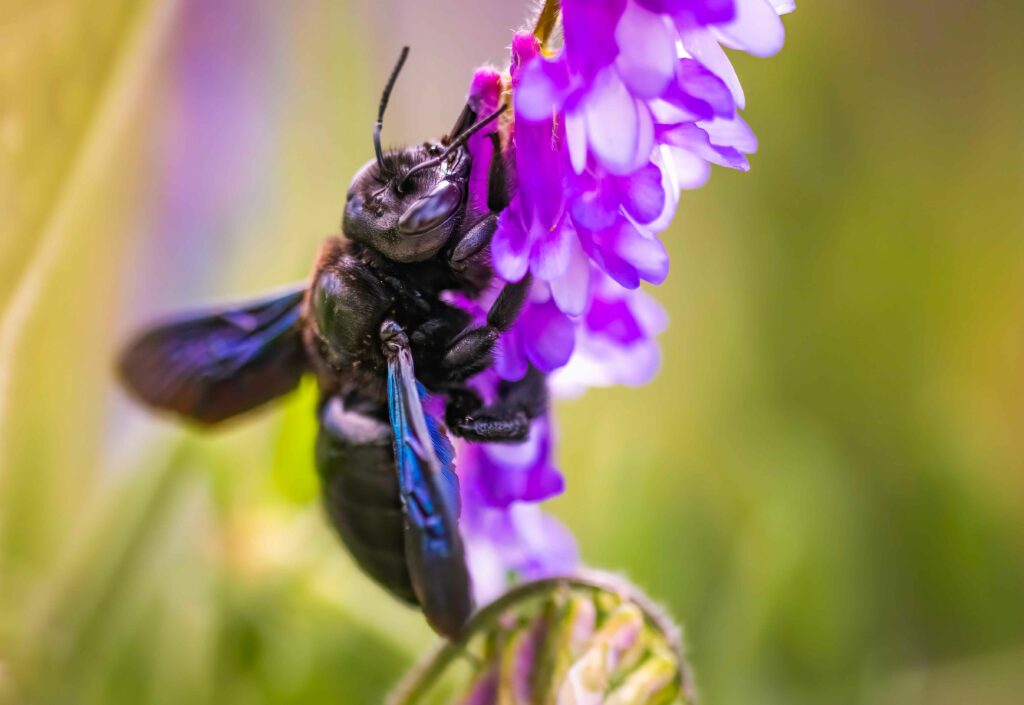Carpenter bees are interesting insects commonly found in ecosystems. People often confuse them with bumblebees. But, they have distinct characteristics and nesting habits from bumble bees.
Carpenter worker bees, unlike social honeybees, live alone. But, do solitary bees, like carpenter bees, produce honey?
Briefly Introducing Carpenter Bees

Let’s explore carpenter bees. They’re hardworking insects found worldwide, with various species adapting to different climates.
Eastern carpenter bees have a unique liking for wood structures. Unlike termites, they don’t eat wood; instead, they make nests inside it.
They make round holes in wood to create nests where they lay eggs and raise their young. You can find these nests in any wooden structures, like eaves, decks, or wooden furniture.
Pose the Question: Do Carpenter Bees Make Honey?
Carpenter bees do not produce honey like other bees. Unlike hive-dwelling bees producing honey, they have a different way of life.
Carpenter bees gather pollen and nectar from flowers for energy. Nectar fuels them as they live their solitary lives, pollinating plants.
Overview of Carpenter Bees
General Information about Carpenter Bees
Carpenter bees, part of the Xylocopidae family, are noteworthy buzzing insects found globally. Their large size, 12 to 25 millimeters, often leads to confusion with bumblebees.
Carpenter bees closely resemble bumblebees but have noticeable differences that set them apart from bumble bees.
Male carpenter bees have a shiny black abdomen without yellow markings, unlike bumblebees. They may also have white or yellow facial markings, setting them apart from other species of bees.
Nesting Habits and Preference for Wood

Carpenter bees have intriguing nesting habits. Unlike honeybees with complex colonies, carpenter bees lead a solitary lifestyle.
Each female carpenter bee creates her own nest without help. What makes them unique is their preference for nesting in wood structures.
Carpenter bees have strong jaws for chewing into wood. They’re attracted to decaying or weathered wood. They create round holes as entrances to their nests.
The holes made by carpenter bees may look intimidating. These holes actually don’t cause structural damage like termites. Carpenter bees excavate existing tunnels and don’t consume the wood. We covered basic details about carpenter bees—like their size, looks, and behavior.
We also looked into their solo living and nesting habits. In particular their liking for wood structures. Stay with us as we move on to section 3 to uncover whether they make honey or not.
The Honey-Making Process

Clarifying honey production associations
When thinking of honey bees, we imagine them buzzing around flowers. They then collect nectar and make their honey. Honey production links to honeybees like the Apis species. This species lives in organized colonies with thousands of individuals. These social insects collaborate to build combs and create delicious honey.
In contrast, carpenter bees (Xylocopa species) follow a different path. These remarkable creatures, belonging to the solitary bee family, lead more independent lives than social bees.
Carpenter bees are often seen around gardens and wood structures. Most common carpenter bee species don’t have large colonies or extensive honey-filled chambers.
Differences in social structure and behavior
Carpenter bees and honeybees play roles in pollination. But, their social structures and behaviors differ. Carpenter bees are a solitary species. They create individual nests instead of working together in a hive.
The female carpenter bee carves tunnels in untreated wood with her strong jaws. These carpenter bees live and create nests with round holes in wooden surfaces like decks or eaves.
Inside these tunnels, the female carpenter bee makes chambers. Some for laying eggs and others for providing food for her larvae. They don’t store extra nectar for adults during challenging times or seasonal changes.
Both bee types are crucial for pollination and our ecosystem. Honey production links to the organized behaviors of honeybees. Carpenter bees focus on the individual bees, nest building, and caring for their offspring.
Carpenter Bee Diet
The Sweet Nectar Quest
When it comes to their dining preferences, carpenter bees have a sweet tooth. Also known as bee’s tongue, or rather, a sweet tongue! These industrious insects are known to be avid nectar collectors.
They use their long tongues, or proboscis, to extract nectar from flowers.
But it’s not about indulging in nature’s sugary delights. Carpenter bees have an essential role as pollinators of flowering plants.
As they sip nectar from one flower to another, tiny pollen grains stick to their fuzzy bodies. Accidental hitchhiking helps flowers cross-pollinate, supporting the reproduction of different plants.
Pollen-Packed Cargo
Carpenter bees view nectar as a treat and pollen as a nutritious meal. They collect pollen from flowers. They do this using specialized bristles on their legs, forming compact “pollen balls.”
Pollen balls nourish adult male carpenter bees. They also serve as provisions for their offspring. Female carpenter bees pack the brood chambers full with pollen balls before sealing them off.
A Beneficial Partnership
Carpenter bees are effective pollinators, contributing to ecosystems and crops. Their dedication to visiting many flowering plants ensures essential pollination across different species. Honeybees are usually linked to honey production. But, we shouldn’t underestimate the role carpenter bees play as pollinators of agricultural crops.
Carpenter bees, unlike honeybees, don’t make honey. Instead, they spread pollen, promoting plant growth and a thriving ecosystem. You won’t find jars of carpenter bee honey in supermarkets. Yet, you can still appreciate these solitary insects. They have distinct feeding habits and make big contributions to the natural world.
Nectar Collection by Carpenter Bees

Buzzing with Pollination Power: Carpenter Bees and Nectar Collection
Carpenter bees are skilled at collecting nectar with their long tongues, called proboscises. Their unique proboscises enable these solitary bees to reach into flowers’ nectar-rich reservoirs.
It’s a sight that showcases both elegance and efficiency. Carpenter bees carefully choose flowers that offer plenty of nectar.
Carpenter bees’ long tongues unfurl like straws to drink nectar. Each time they dip their tongues into the flowers, they extract sugary nectar for energy.
The Pollen Powerhouse: Carpenter Bees as Master Pollinators
But collecting nectar is not the only task at hand for carpenter bees. These industrious insects become important pollinators as well.
As carpenter bees sip nectar, pollen sticks to their fuzzy bodies. Especially the thorax and abdomen, as they dive into flowers.
As carpenter bees move between flowers for nectar, they unintentionally transfer pollen. This aids in plant reproduction by gathering pollen and delivering it onto other flowers’ stigmas.
It’s like nature’s very own matchmaking service! Carpenter bees’ role as pollinators extends beyond collecting and transferring pollen.
Certain bees use buzz pollination to extract pollen from specific flowers. Carpenter bees collect pollen that adheres to their hairy bodies.
Collecting pollen incidentally enables carpenter bees to sustain themselves. They are also able to provide for their larvae in nesting sites. Carpenter bees don’t produce honey like other bees, but they play a big role in pollinating plants.
Carpenter bees, with their long tongues, excel at collecting nectar and transferring pollen. This makes them excellent pollinators. If you see a carpenter bee sipping nectar in a garden, take a moment to appreciate their role in our ecosystem.
The Honey Storage Process of Carpenter Bees: Nectar for Larval Development

Unlike honeybees, the eastern carpenter bee has a distinct approach to honey production. Instead of storing honey, eastern carpenter bees gather nectar for a different purpose. They regurgitate the nectar into small chambers within nests to begin the process.
The chambers aren’t for honey storage; they’re crucial for developing carpenter bee larvae. First, the female carpenter bee lays eggs in wood nests. Then, the female ensures each chamber has enough nectar for the growing larvae.
The female bee carefully stocks these chambers with nectar from different plants. This sustenance provides essential nutrients and energy for the larval stage of development.
Differences Between Carpenter Bee and Honeybee Honey Production
Honeybees make honey using complex processes, creating sugars unique to their species. Carpenter bees though, don’t produce honey in the same elaborate way.
Honeybees use honey as a primary food source for themselves and their colonies. Carpenter bees don’t produce or store traditional honey like honeybees or native bees.
Instead, they use stored nectar to feed their larvae. The larvae eat this nectar until they grow into mature adult bees. Once grown they are ready to pollinate and contribute to ecosystems.
The Benefits of Carpenter Bees to Ecosystems: Pollinators and Biodiversity
Carpenter bees play a crucial role in ecosystems by maintaining a delicate balance. They are effective pollinators, ensuring the reproductive success of many plant species.
Carpenter bees collect nectar from flowers, transferring pollen and aiding in fertilization. This pollination service ensures the survival of plant species and contributes to biodiversity.
Carpenter bees are less aggressive than honeybees or bumblebees. Female carpenter bees rarely use their stinger unless provoked or threatened.
Conclusion
Carpenter bees don’t make honey like honeybees. But carpenter bees do store nectar for larval development. This plays a big role in the life cycle of the ecosystem. As native pollinators, these solitary creatures act as nature’s gardeners. Supporting the reproduction and survival of many plant species.
Carpenter bees, with their gentle nature and role in biodiversity, are very valuable. Let’s appreciate these fascinating creatures and support their habitats. Each buzzing carpenter or honey bee hive is a significant contributor to the tapestry of life.
Get Rid of Bees with B-Termination: Las Vegas’ Top-notch Pest Control!

Facing bee issues on your Las Vegas property? D-Termination is ready to assist. Our skilled team is dedicated to eradicating bee infestations, bringing back comfort and tranquility to your area. Bid farewell to bees—opt for D-Termination for efficient pest control now!
Reach out to us at 702-919-6310 or go to dtermination.com to schedule your bee control service and regain control of your space from these bothersome insects.
Frequently Asked Questions:
Carpenter bees are pollinators and play a role in plant reproduction.
Honey bees are typically smaller and have more body hair than carpenter bees.
Carpenter bees can cause damage to wooden structures as they bore into them to create nests.
Yes, carpenter bees can be considered nectar robbers in some cases.








